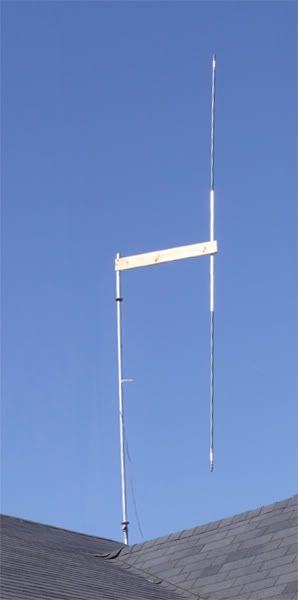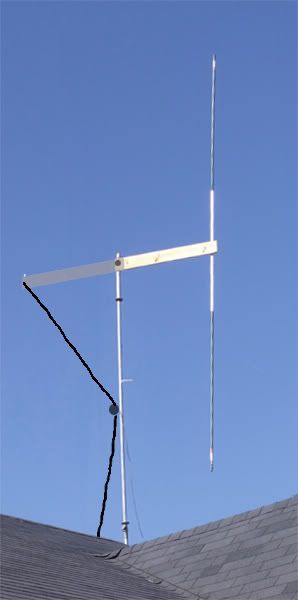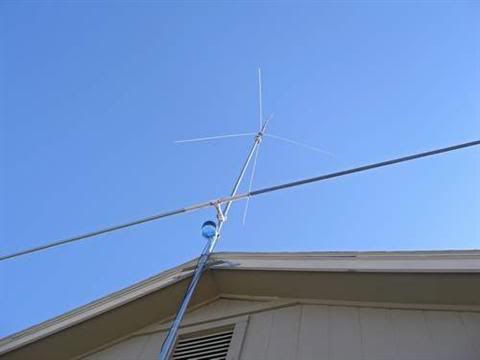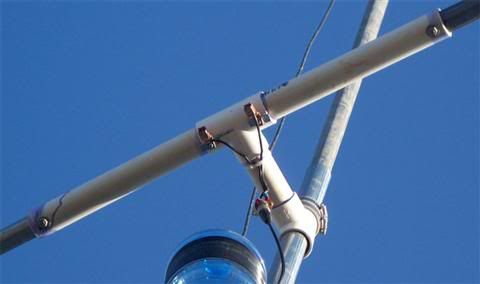I will do what I can with your questions. Perhaps others will add some ideas regarding the rotatable questions.
I have made sure that the lower end of the dipole be a minimum of 18" - 24" from the mast on which it is mounted. Although in the original post above I said to use a 1' length of PVC as the lower insulator, since then others have found that length puts the lower end of the dipole too near the mast.
I have used treated wood planks, too. The advantage of wood planks is the use of u-bolts on both the mast and the lower dipole end simplifies the mechanics of attaching either. In fact, I have used planks for the center insulator, too. A wood picket from your local Home Depot is an easy acquisition, but there is a slight weight increase over fiberglass tube, and a little more wind load.
In post #1 at the beginning of the thread both methods can be seen in the photos.
In the first one could extend a boom beyond the mast and simply use mechanisms from as simple as a rope/cable on the end opposite of the dipole and pivot the dipole up or down for the two polarization/orientations. Crude but simple:


A second way would be to simply devise a method of rotating a dipole from its own center.

The simplest is to purchase a TV rotor. This dipole is so light, and has such a small amount of wind load, that the TV rotor would handle it with room to spare. Simply add a tee to the center insulator as in the photo and put it directly into the rotor and you're done.

Thanks, Robb
My experience has been limited to what I've done with those I've made, but questions regarding high SWR from others when they made one of these has led me to recommend what I've done for this issue.Some questions do come up here:
*When erecting this vertical dipole, how far away from the end of this dipole should this dipole need to be from any metal? Since the voltage max of a dipole is at the ends; then it will need to be a given distance away from any metal to keep it from 'capacitive detuning' of the same dipole.
I have made sure that the lower end of the dipole be a minimum of 18" - 24" from the mast on which it is mounted. Although in the original post above I said to use a 1' length of PVC as the lower insulator, since then others have found that length puts the lower end of the dipole too near the mast.
I like fiberglass tubing the best. I have used the handles from post hole diggers for this, and like it. It is sturdy, and is tubular. The tubular shape makes it possible to slip the lower end of the dipole directly into it and with SS bolts through it all makes for an easy installation to the mast using U-bolts. Also, it has less wind load than using wood planks. It does not have any RF properties, and is strong.*What kind of dielectric material would you prefer to keep it strong and insulate it from the dipole and the mounting mast?
I have used treated wood planks, too. The advantage of wood planks is the use of u-bolts on both the mast and the lower dipole end simplifies the mechanics of attaching either. In fact, I have used planks for the center insulator, too. A wood picket from your local Home Depot is an easy acquisition, but there is a slight weight increase over fiberglass tube, and a little more wind load.
In post #1 at the beginning of the thread both methods can be seen in the photos.
The closest photos I have are some that shows the potential for making it rotatable as I've never done that.*Is there any practical ways that you can demonstrate to make this dipole rotatable from the vertical polarization to the horizontal polarization?
In the first one could extend a boom beyond the mast and simply use mechanisms from as simple as a rope/cable on the end opposite of the dipole and pivot the dipole up or down for the two polarization/orientations. Crude but simple:


A second way would be to simply devise a method of rotating a dipole from its own center.

*For that matter, is there a practical way to make it rotatable in a 360 degrees when in the horizontal polarization?
The simplest is to purchase a TV rotor. This dipole is so light, and has such a small amount of wind load, that the TV rotor would handle it with room to spare. Simply add a tee to the center insulator as in the photo and put it directly into the rotor and you're done.

Nice work, Homer!
Thanks, Robb
Last edited:
